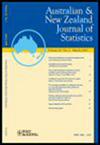Dependent radius marks of Laguerre tessellations: a case study
Abstract
We study a particular marked three-dimensional point process sample that represents a Laguerre tessellation. It comes from a polycrystalline sample of aluminium alloy material. The ‘points’ are the cell generators while the ‘marks’ are radius marks that control the size and shape of the tessellation cells. Our statistical mark correlation analyses show that the marks of the sample are in clear and plausible spatial correlation: the marks of generators close together tend to be small and similar and the form of the correlation functions does not justify geostatistical marking. We show that a simplified modelling of tessellations by Laguerre tessellations with independent radius marks may lead to wrong results. When we started from the aluminium alloy data and generated random marks by random permutation we obtained tessellations with characteristics quite different from the original ones. We observed similar behaviour for simulated Laguerre tessellations. This fact, which seems to be natural for the given data type, makes fitting of models to empirical Laguerre tessellations quite difficult: the generator points and radius marks have to be modelled simultaneously. This may imply that the reconstruction methods are more efficient than point-process modelling if only samples of similar Laguerre tessellations are needed. We also found that literature recipes for bandwidth choice for estimating correlation functions should be used with care.

 求助内容:
求助内容: 应助结果提醒方式:
应助结果提醒方式:


